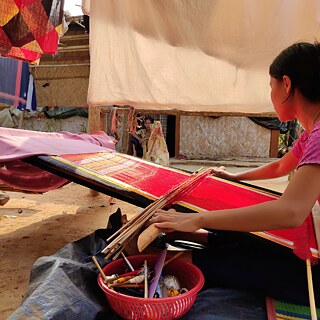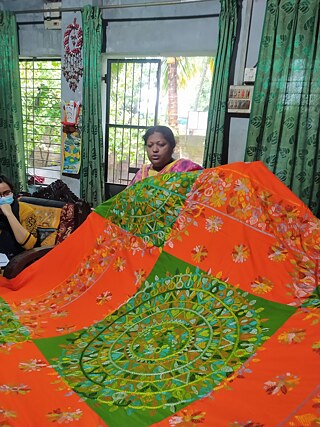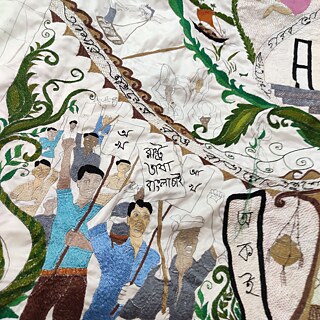Behind the scenes of crafts(wo)manship: The good & the ugly

Supply chains faced obstacles during the Covid pandemic. Stimulus packages were introduced. However, little was done for women artisans. But activists and promoters of arts and crafts in Bangladesh seek to change mindsets.
By Mahenaz Chowdhury
With that thought, I wondered how this nation survived the pandemic and managed to pull through. As nationwide mobility was disrupted, supply chains faced severe obstacles leading to businesses reducing their operational sizes and some even shutting down. Everything took a toll on the daily lives of people, especially cottage and small and medium sized enterprises (SMEs) that employed home based women workers in the handicrafts industry. With people out of jobs, the need to purchase handmade products was low, the demand was more on functional items.
While there are a million SMEs in Bangladesh that contribute to 23% of the nation’s GDP only 10% of these are SMEs owned and led by women. To put that into context, it is these SMEs that enable the country to thrive through 80% of job creations in various off-farm industries. We saw stimulus packages initiated by the government but very little done to target women effectively in order to support the economic sustenance of their business and families because their need was not a substantial figure for the policy makers and private or public market players to take notice of. It is evident that market players run after big targets because it is easier to manage.
Part of my trip was to learn about the experiences of women entrepreneurs and artisans who were employed by the women owned or women led businesses across Jessore coping during the lockdown. In my interview with Nurun Nahar Lily, an entrepreneur and a social activist in her area, she explains, “I live with my two brothers and their wives. After my father passed away it has been upon me to provide for this family. Life has been a hustle ever since till now and I have grown a liking to it but the pandemic wasn’t easy for us. My business is catered around selling nakshi kantha bed covers and home decor products. Being an entrepreneur, I have a responsibility towards the craftswomen who have been with me for years creating these beautiful artworks. Since operations were off due to lockdowns, the business wasn't making any money at the time. It was out of my savings that I paid them on a monthly basis. But I had my own family to take care of too.”
The philosophy of enabling women to work should be embedded with the factors that create a nurturing ecosystem for them at both their workplace and at home is crucial for longevity of craftsmanship in this country. With only 36.6% of women in the workforce compared to a staggering 81.7% of men controlling the labor market, this disparity is one of the leading reasons for economic and social hindrance to women who want to achieve an independent identity of their own. During the lockdowns, we noticed that domestic abuse was on the rise, as women were at risk since their husbands were either laid off or were forced to stay at home. We witnessed patriarchy at its worst.
Summarizing her experiences, Lily mentions, “I have been fighting for women’s rights and I do gender advocacy amongst my network. We saw horrible incidents happen during these times and through counseling so much of it can be solved. Crafts are created out of the homes of the majority of the artisans I employ along with other employers in this region. These women need a safe environment to create the art they do and provide for their family.”
As she said that, I recalled reading about Ruby Ghuznavi in an article, one of the most incredibly dynamic women, an activist, environmentalist and craft specialist who had tremendous contributions in the preservation and growth of the heritage of crafts in Bangladesh for decades and simultaneously advocated and worked towards empowering women and children. She quite simply pointed out, “We need to work together to change this mindset, even if it takes us a few more centuries to do so. Parents must be more open minded and treat their children equally. They must bring up their children in a way that makes them confident and independent. They must sensitise their sons, to these issues so they do not think of themselves as superior to the opposite sex.” - The Daily Star, 2011
When you start putting the puzzle pieces together, you truly can understand the long historical connection of crafts, women & violence. It has always been a very powerful and personal way of portraying memories especially when it comes to Nakshi Kantha. After the 1971 Liberation War between Bangladesh and Pakistan, many women were left traumatized and speechless. Maleka Khan, an author and a social worker, had adopted the method of using Nakshi Kantha as a tool to use as occupational therapy with the victims. She recalls her experience working as rehabilitator in an interview with Daily Star, “The trauma afflicted by the Pakistani troops on the women of Bengal in '71 left them emotionally numb and physically unresponsive. It was as if their mouths were numbed and their ears deaf; nevertheless, their eyes screamed with silent tears. Upon nudging her to open up, she asked for a needle and a thread, which I provided from torn borders of old saris at once. Conjuring up all her concentration, stitch by stitch and layer by layer, I stood by in wonder as she created a small kantha with a plain border and a simple design. This is how we eventually nursed some of the victims back to health: by engaging them in an everyday skill that allowed their subconscious minds to cope and, thankfully, overcome.”- The Daily Star, 2019
Sitting across Lily, I realized how complex the realities are but she hadn't given up once. Much like Maleka & Ruby Ghuznavi, Lily is a living hero of our times. Their values of life and the principles they live by, is incomparable to the leaders we see up on stage talking out of their privileged positions churning profits year after year. “Unless you see with your own eyes the amount of work that goes into making kanthas, jamdanis or even print work, you cannot understand why these products cost so much.” - Ruby Ghuznavi, The Daily Star, 2011. The crafts industry is the heart of our nation as much as the RMG sector is, but we fail to recognize the contribution these women make everyday into our nation’s economy. There are factors that are beyond profitability and large infrastructure and industrialization, which needs to be taken into account to nurture our craftswo(men) to help them grow and to inspire others to get into this beautiful art world.


